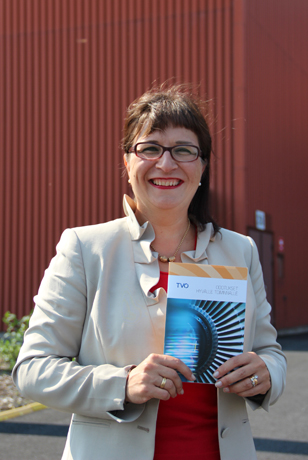Even safer working
TVO has carried out self-assessments of safety culture already for several years. Various tools have been developed on the basis of the assessments for improvement of practices; one of these tools, the field observations method, has now been adopted widely by TVO's various organisations.
The method of field observations was launched on a wider scale last autumn and winter. It had previously been used in Production, but the methodology was expanded to cover all the technical organisations. Office Manager Nina Paaso in Operations Support, what is the field observations method?
– It was decided to include field observations in the toolbox despite the already high professional ethics and competence of Finnish people. Field observations can be used to increase the sharing of good practices, to prevent human errors and to eliminate any discrepancies. Field observations are not designed for audit purposes, but to improve operations through joint efforts. The more pairs of eyes, the better the chances that any risks are detected and we can increase the safety level of our operation.
A similar method of observations is used e.g. at the Forsmark nuclear power plant in Sweden. – From now on we can compare with them our experiences in the effectiveness of field observations. I am sure we will also obtain new tips for the development of our operating practices. The same model is also used in, for example, England and France, so operational experience feedback will be available also from those countries.
Good results through discussions
The field observations method involves visits to predetermined areas of the plant to make observations against the expectations and procedures specified by TVO.
– After observations have been made, it is important to discuss them with the people concerned. That is the right way to deal with observations. We must all acknowledge that the main objectives of field observations are to ensure that good operating practices and attitudes are developed and appreciated, to remind about the significance of the requirements specified for work and to utilise the professional skills of the personnel to make working easy.
The field observations method comprises four main phases, which are the preparatory phase, the execution of observation, the verification of facts as well as reporting. The preparatory phase is of particular importance and it is not sensible to make observations without the preparatory phase.
 – One must identify the matters that are observed. And we must also learn from practices that are proven good in field observations.
– One must identify the matters that are observed. And we must also learn from practices that are proven good in field observations.
From observations to improved safety
The observations are recorded in an information system for use by a specific working group with in-depth knowledge of the subject; the working group analyses the observations, searches for similar operating practices or areas that need improvement.
The observer then discusses the areas that need further development or improvement with the responsible organisation that has to rectify the deficiencies, or as the case may be, highlight good practices more clearly.
According to Paaso, both the observers and the people who have been observed have accepted the new method with positive attitudes.
– It is great to see that this method has been well integrated in everyday operations. However, we must remember that although we are creating and developing a new method of observations, we all still have the duty to challenge any discrepancies that we detect. This way we can ensure safe working conditions for all of us, Ms. Paaso sums up.
Nina Paaso holding a brochure that presents TVO's expectations for good practices.
Share